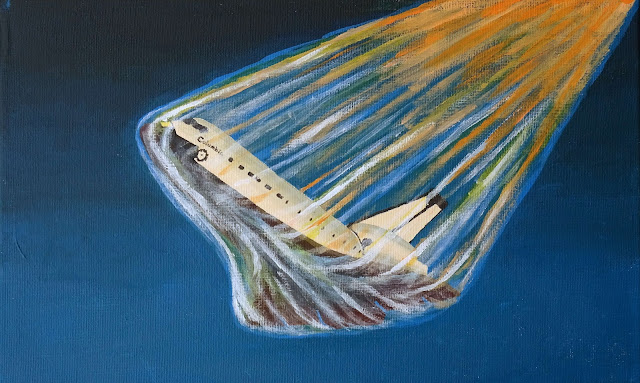A bright star streaks across the sky, leaving behind a glowing trail that soon fades back into the blackness of the night sky, leaving no perceptible trace. A minute later, another streak appears; this one has faint hues of pink and orange. Each streak lasts only a couple seconds, but its quiet beauty is not easily forgotten.
Maybe I could write a kid's book about it:
Fast star, slow star
Red star, blue star
The sight I'm describing is called a meteor (as I'm sure you already know). Meteors have been observed for as long as humans have existed, and have been a mystery for almost as long. It didn't take long to figure out that they occurred high in the atmosphere - in fact, the name "meteor" was originally used for any atmospheric event - but it wasn't until the 19th century that somebody finally realized what they actually were: small bits of space debris burning up as they fell through the sky.
The question that naturally comes next: how does a meteor get so hot?
Well, for starters, it's not friction. We know that friction can produce a lot of heat, so it might sound like a good explanation, but friction alone would not produce a bright enough glow. The main source of heat is something a little different.
When air is quickly and violently compressed, its temperature increases. When an object moves through air faster than the speed of sound, it produces a shock wave; the sudden high pressure in the shock wave, called "ram pressure," causes the air to become hot. If the object is moving fast enough, the air can become hot enough to produce light. Meteors, which move anywhere from 32 to 200 times the speed of sound, easily heat the air to this point - the light that we see coming from a meteor is not the debris itself, but the shock-heated air flowing around it. This hot air is also what vaporizes the meteor.
The production of heat from ram pressure can be problematic for supersonic aircraft, which (just like space debris) can be damaged from its effects. The outside of the Concorde would get as hot as boiling water during its super-sonic flights, when it reached speeds up to Mach 2; to ensure that the airplane wasn't damaged, the pilot flew for . These speeds were not fast enough to produce visible light, however; the only man-made vehicles that move fast enough to produce plasma are re-entering space vehicles.
During reentry after an STS mission, the space shuttle had a speed a little below 25 times the speed of sound. This heated the air to very high temperatures, producing a glow not unlike a very large meteor. The thousands of tiles on the space shuttle insulated it from most of the heat, so that it wouldn't disintegrate; the black tiles reached temperatures as high as 3000 °F, which was 10 times hotter than the aluminum structure could withstand. A single missing tile could mean disaster.
Luckily, there have only been two space shuttles that were damaged in this way. The most famous is Columbia, which was destroyed during reentry. The whole crew was killed in that awful disaster. The other is Atlantis, which (amazingly) survived severe damage during STS-27. During launch, foam insulation from a fuel tank detached and hit the underside of the orbiter. Many tiles were damaged, and one of the black tiles was completely knocked off. Before reentry, the crew members noticed the damage and sent video footage back to NASA, who thought it was image artifacts and told them it was okay. The commander thought they would die, but he had no choice but to proceed. Luckily, the spot where the missing tile had been was above a thick metal mounting plate; during reentry the plate was partially melted, but it saved the shuttle and crew from destruction. (For more info, read the article on Spaceflight Now.)
Reentry is fascinating. It's fun to learn about, and I bet it's even more fun to experience. Unfortunately, it would cost a fortune to experience it, so instead I painted it. I painted the scene in layers. First I painted the space shuttle and the background, and then I added blue plasma. Then I added the white and orange plasma using semi-transparent paint. I know I'll have this painting for years to come; in some ways, that's almost as good as riding in a space shuttle.
Just kidding - it's only a painting. I guess I better start saving up money.
New posts every month - subscribe for free!




Are you still making posts?
ReplyDelete